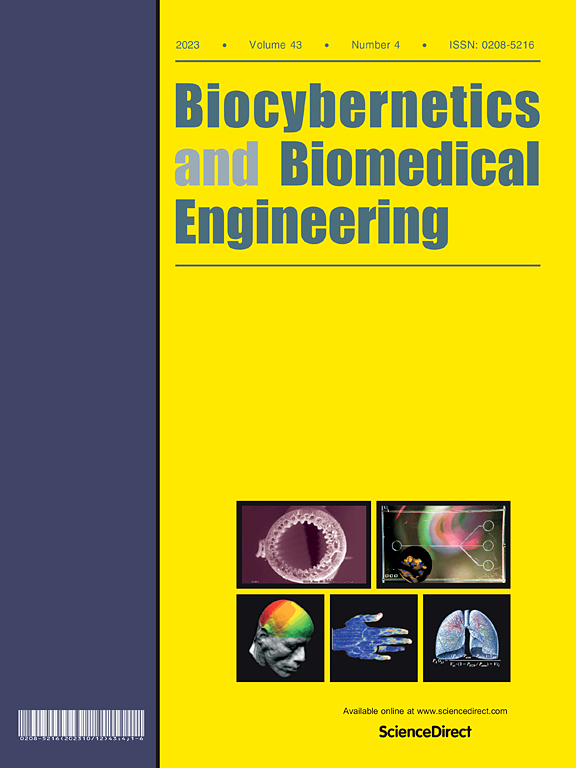基于功能近红外光谱的轻度认知障碍多尺度神经网络分类
IF 6.6
2区 医学
Q1 ENGINEERING, BIOMEDICAL
引用次数: 0
摘要
轻度认知障碍(MCI)被认为是阿尔茨海默病的早期阶段。功能近红外光谱(fNIRS)最近被用于通过分析MCI患者的血流动力学反应来区分他们与健康对照(hc)。本文提出了一种利用所有fNIRS通道的整个时间序列数据,跳过特征提取步骤的新方法。该方法采用多尺度卷积神经网络(CNN)和长短期记忆(LSTM)层相结合的方法同时提取时空特征。这项研究涉及64名参与者(37名轻度认知障碍患者和27名hcc患者),他们执行三项心理任务:N-back、Stroop和语言流畅性测试(VFT)。该算法的性能通过氧合血红蛋白(HbO)、脱氧血红蛋白(HbR)和总血红蛋白(HbT)的10倍交叉验证进行评估。HbT的分类准确率最高,N-back任务为93.22%,Stroop任务为91.14%,VFT为89.58%。研究发现,使用来自所有通道的所有类型的血流动力学信号比分析感兴趣区域的数据提供了更好的结果,消除了对数据分割和特征提取过程的需要。此外,HbR(或HbT)提供比HbO更好的分类精度。所开发的方法可以在线实施,用于临床应用和实时监测认知障碍。本文章由计算机程序翻译,如有差异,请以英文原文为准。
Multi-scale neural networks classification of mild cognitive impairment using functional near-infrared spectroscopy
Mild cognitive impairment (MCI) is recognized as an early stage preceding Alzheimer’s disease. Functional near-infrared spectroscopy (fNIRS) has recently been used to differentiate MCI patients from healthy controls (HCs) by analyzing their hemodynamic responses. This paper proposes a new method that uses the entire time series data from all fNIRS channels, skipping the feature extraction step. It involves a multi-scale convolutional neural network (CNN) integrated with long short-term memory (LSTM) layers to extract spatial and temporal features simultaneously. The study involves 64 participants (37 MCI patients and 27 HCs) performing three mental tasks: N-back, Stroop, and verbal fluency tests (VFT). The algorithm’s performance was assessed using 10-fold cross-validation across oxyhemoglobin (HbO), deoxyhemoglobin (HbR), and total hemoglobin (HbT). The highest classification accuracies were achieved with HbT, reaching 93.22 % for the N-back task, 91.14 % for the Stroop task, and 89.58 % for the VFT. It was found that using all types of hemodynamic signals from all channels provides better results than analyzing the region of interest data, eliminating the need for data segmentation and feature extraction procedures. Additionally, HbR (or HbT) gives better classification accuracy than HbO. The developed method can be implemented online for clinical applications and real-time monitoring of cognitive disorders.
求助全文
通过发布文献求助,成功后即可免费获取论文全文。
去求助
来源期刊

Biocybernetics and Biomedical Engineering
ENGINEERING, BIOMEDICAL-
CiteScore
16.50
自引率
6.20%
发文量
77
审稿时长
38 days
期刊介绍:
Biocybernetics and Biomedical Engineering is a quarterly journal, founded in 1981, devoted to publishing the results of original, innovative and creative research investigations in the field of Biocybernetics and biomedical engineering, which bridges mathematical, physical, chemical and engineering methods and technology to analyse physiological processes in living organisms as well as to develop methods, devices and systems used in biology and medicine, mainly in medical diagnosis, monitoring systems and therapy. The Journal''s mission is to advance scientific discovery into new or improved standards of care, and promotion a wide-ranging exchange between science and its application to humans.
 求助内容:
求助内容: 应助结果提醒方式:
应助结果提醒方式:


